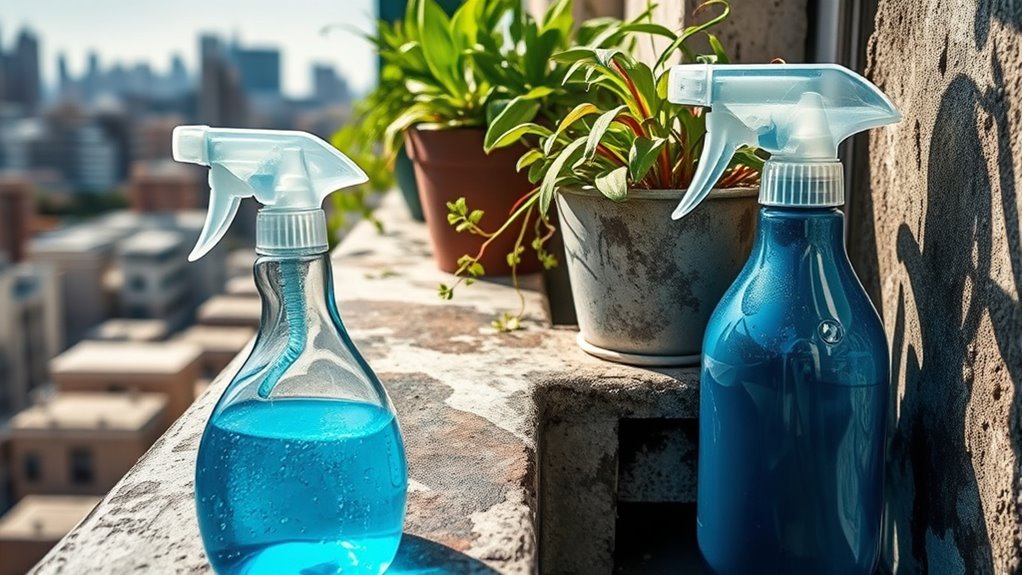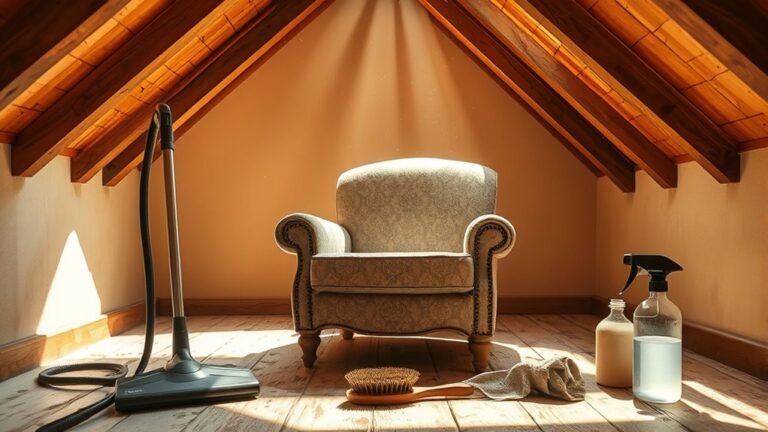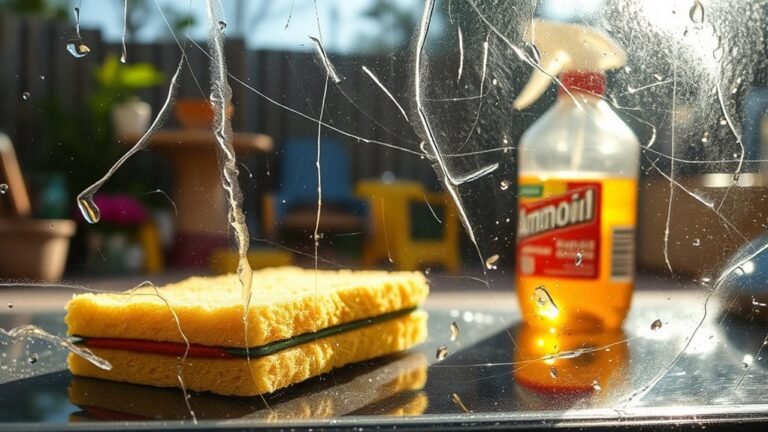How to Remove Mold From Balcony
To remove mold from your balcony, first identify visible discolorations and musty odors. Wear protective gear like gloves and an N95 mask, and guarantee good ventilation. Clear furniture and debris, then apply mold-targeted cleaners or homemade solutions such as undiluted vinegar and baking soda paste. Scrub with appropriate brushes, rinse with a low-pressure hose, and dry thoroughly to prevent regrowth. If mold covers large areas or recurs, professional help may be necessary. Learn how to maintain a safe, mold-free balcony environment.
Identifying Mold on Your Balcony

How can you tell if mold is growing on your balcony? First, look for discolorations—black, green, or white patches—that often appear on damp surfaces. Mold types vary, with common ones like Aspergillus and Cladosporium thriving in moist, shaded areas. You may notice a musty odor, signaling mold presence even before visible signs. Mold causes include poor ventilation, water accumulation, and organic debris. Identifying mold early means observing these environmental factors and inspecting corners, grout lines, and under furniture. Since mold spores are microscopic, their growth is often subtle initially. You can prevent extensive colonization by monitoring humidity and keeping the balcony dry. Understanding mold types and causes empowers you to maintain a clean, safe outdoor space, preserving your freedom to enjoy your balcony without health risks.
Safety Precautions Before Mold Removal
Before you start removing mold from your balcony, make certain you wear proper protective gear like gloves, a mask, and goggles to prevent exposure to harmful spores. You’ll also need to guarantee good ventilation by keeping doors and windows open to promote airflow. These steps minimize health risks and improve the effectiveness of the cleaning process.
Protective Gear Essentials
Wearing the right protective gear is vital when tackling mold removal on your balcony to minimize exposure to harmful spores. Start with high-quality protective masks, such as N95 respirators, which effectively filter airborne mold particles and prevent respiratory irritation. Avoid simple cloth masks, as they don’t provide adequate protection. Next, wear durable rubber gloves to shield your hands from mold and cleaning agents, reducing the risk of skin irritation or infection. It’s important to select gloves that fit properly to maintain dexterity and avoid accidental contact with contaminated surfaces. Additionally, consider wearing long sleeves and eye protection to prevent spores from contacting your skin and eyes. Equipping yourself with appropriate gear preserves your health and guarantees you maintain the freedom to safely restore your balcony’s environment.
Ventilation and Airflow
Once you’ve equipped yourself with proper protective gear, ensuring adequate ventilation becomes your next priority. Effective airflow management reduces airborne mold spores, minimizing inhalation risks during removal. Open all balcony doors and windows to create cross-ventilation, allowing fresh air to circulate freely. Use fans strategically to direct airflow away from living spaces, enhancing ventilation strategies. Avoid recirculating air within confined areas, as this can spread mold particles. If possible, consider using an exhaust fan to expel contaminated air outdoors. Maintaining consistent airflow not only protects your respiratory health but also accelerates drying, discouraging mold regrowth. By implementing these ventilation strategies, you gain control over the environment, safeguarding your freedom to work safely and efficiently on your balcony mold removal project.
Gathering Essential Cleaning Supplies

Although mold removal can be straightforward, gathering the right cleaning supplies is essential to guarantee effective and safe treatment. To protect both your health and the environment, select appropriate cleaning products, favoring eco friendly options when possible. Here are three critical items to assemble before starting:
- Cleaning Products: Use mold-specific cleaners or a diluted bleach solution; eco friendly options like vinegar or baking soda are effective and less toxic.
- Protective Gear: Gloves, goggles, and a mask prevent exposure to mold spores and harsh chemicals.
- Scrubbing Tools: Stiff brushes or sponges designed for outdoor surfaces will aid in physically removing mold.
Preparing the Balcony for Cleaning
Before you start cleaning, remove all debris and furniture from the balcony to expose the affected areas fully. Make sure the space is well-ventilated to minimize inhalation of mold spores and cleaning agents. Proper preparation reduces contamination risk and improves cleaning effectiveness.
Clear Debris and Furniture
Start by removing all debris and furniture from your balcony to create an unobstructed workspace. Effective debris removal is crucial to prevent mold spores from spreading during cleaning. Follow these steps to guarantee proper furniture placement and maintain safety:
- Collect loose debris such as leaves, dirt, and organic matter using a broom or vacuum, disposing of it in sealed bags to limit contamination.
- Relocate furniture to a dry, shaded area with good airflow, preventing moisture accumulation that encourages mold growth.
- Inspect furniture surfaces for mold or moisture, cleaning or treating affected pieces before returning them to the balcony.
Ensure Proper Ventilation
Proper ventilation is essential to reduce airborne mold spores and moisture during cleaning, protecting both your health and the balcony structure. To maximize air circulation, open all accessible windows and doors leading to the balcony, allowing fresh air to flow freely. If your balcony is enclosed, consider installing a portable fan to enhance airflow, which will help disperse spores and speed up drying. Additionally, exposing the area to natural light can inhibit mold growth by lowering humidity and creating an inhospitable environment for spores. Avoid cleaning on stagnant, humid days since poor ventilation can trap moisture, increasing mold proliferation. By ensuring proper ventilation, you create safer conditions for yourself and effectively prevent mold from returning, granting you freedom from persistent contamination on your balcony.
Effective Homemade Solutions for Mold Removal

Although commercial mold removers are effective, you can achieve similar results using homemade solutions that are both safe and economical. To remove mold from your balcony, try these precise methods:
You can effectively remove balcony mold using safe, affordable homemade solutions instead of commercial products.
- Vinegar solution: Spray undiluted white vinegar on moldy areas. Let it sit for at least an hour before scrubbing. Vinegar’s acidity disrupts mold growth effectively.
- Baking soda paste: Mix baking soda with water to form a paste. Apply it to mold, then scrub after 10 minutes. Baking soda neutralizes odors and inhibits mold spores.
- Combined treatment: After vinegar, apply baking soda, then rinse. This two-step approach enhances mold removal and prevents recurrence.
Using Commercial Mold Removers Safely
When choosing commercial mold removers, you should select products specifically formulated for outdoor surfaces and verify their active ingredients for effectiveness. Always follow safety precautions like wearing gloves, masks, and ensuring proper ventilation to minimize exposure to harmful chemicals. Proper application and disposal according to manufacturer guidelines are essential to prevent environmental contamination and health risks.
Choosing Effective Mold Removers
Since mold can damage your balcony’s structure and pose health risks, selecting an effective mold remover is essential. You want a solution that’s both powerful and considerate of your environment. Here’s how to choose wisely:
- Prioritize natural mold solutions and eco friendly removers to minimize harmful chemical exposure and environmental impact.
- Look for products with proven antifungal properties, such as those containing hydrogen peroxide or tea tree oil, ensuring effective mold elimination.
- Verify that the remover is suitable for your balcony’s materials—concrete, wood, or metal—to prevent surface damage.
Proper Safety Precautions
Taking five essential safety precautions will help you use commercial mold removers effectively while protecting your health and property. First, identify the mold types present, as some release spores that pose significant health risks. Always wear protective gear—gloves, goggles, and an N95 mask—to prevent skin contact and inhalation of harmful particles. Guarantee proper ventilation by opening doors and windows, allowing fresh air to disperse toxic fumes from the remover. Avoid mixing chemicals to prevent dangerous reactions. Finally, keep children and pets away during treatment to minimize exposure risks. By following these safety steps, you maintain control over mold removal without compromising your freedom to enjoy a clean, healthy balcony environment.
Application and Disposal Guidelines
Several key steps guarantee you apply commercial mold removers effectively and dispose of them safely. First, always follow the product’s instructions for dilution and application to maximize efficacy while minimizing health risks. Second, make sure the area is well-ventilated to prevent inhalation of fumes, protecting your freedom to breathe clean air. Third, after treatment, use appropriate disposal methods for residual remover and contaminated materials—seal them in plastic bags to prevent spore spread and follow local regulations for mold disposal. By adhering to these precise steps, you maintain a controlled environment, prevent contamination, and comply with safety protocols. This methodical approach safeguards both your health and the environment, making certain mold removal is thorough and responsible without compromising your autonomy.
Scrubbing and Cleaning Techniques
Begin by choosing the right tools and cleaning agents to effectively remove mold from your balcony surfaces. Different mold types demand specific approaches; for example, porous materials require gentle scrubbing to avoid damage, while hard surfaces tolerate firmer brushes. Use a stiff-bristled brush for concrete or tiles and a soft-bristled one for wood. Apply a mold-specific cleaner or a diluted bleach solution to disrupt mold growth. Scrub methodically, covering all affected areas to remove biofilms thoroughly. Maintain a consistent cleaning frequency based on environmental conditions—humid areas need more frequent attention to prevent mold recurrence. By adopting precise scrubbing techniques, you minimize mold spores’ spread and protect your balcony’s integrity, granting you the freedom to enjoy a clean, healthy outdoor space without constant worry.
Rinsing and Drying the Balcony Properly
Once you’ve thoroughly scrubbed the mold, rinsing the balcony properly is essential to remove residual cleaning agents and loosened mold particles that could promote regrowth. To guarantee effective rinsing and drying, follow these steps:
- Use a low-pressure hose to gently wash away residues, avoiding high pressure that may damage surfaces and embed mold deeper.
- Apply rinsing techniques that focus on all corners and crevices to prevent leftover moisture pockets.
- Employ drying methods such as using absorbent towels or enabling natural airflow by opening windows and doors, accelerating evaporation.
Precision in rinsing and drying not only clears contaminants but also minimizes moisture retention, a critical factor in mold prevention. Proper execution gives you freedom from recurring mold issues and maintains a healthy balcony environment.
Preventing Mold Regrowth on Your Balcony
Although thorough cleaning and drying reduce mold presence, preventing regrowth requires ongoing control of moisture and environmental conditions on your balcony. You should apply mold resistant coatings designed to inhibit fungal growth on surfaces exposed to humidity. These coatings create a protective barrier, limiting mold’s ability to establish. Additionally, effective balcony drainage solutions are essential to prevent water accumulation, which fosters mold proliferation. Ascertain gutters and drains are clear and functioning properly to direct water away swiftly. Regularly inspect these systems and the balcony surface for signs of water retention or damage. By combining mold resistant coatings with reliable drainage, you actively reduce moisture levels and create an environment unfavorable to mold. This proactive approach gives you freedom from recurring mold problems and maintains the balcony’s structural integrity.
When to Seek Professional Mold Remediation
If mold covers a large area of your balcony or penetrates porous materials, you should consider professional mold remediation. Seeking expert help guarantees thorough removal and prevents health risks. Here’s when to contact mold inspection services for a professional assessment:
- When mold growth exceeds 10 square feet, signaling extensive contamination.
- If mold recurs despite your cleaning efforts, indicating hidden sources or structural issues.
- When you experience allergic reactions or respiratory symptoms linked to mold exposure on your balcony.
Professional remediation uses specialized equipment and techniques to eradicate mold safely, protecting your freedom to enjoy your outdoor space. Early intervention through mold inspection services can save you time, money, and potential health complications. Don’t hesitate—prioritize a professional assessment to maintain a safe, mold-free balcony environment.
Häufig gestellte Fragen
Can Mold on Balconies Affect Indoor Air Quality?
Yes, mold on balconies can impact your indoor air quality. When outdoor mold spores become airborne, they can easily enter your living space, increasing indoor mold levels. This can trigger allergies and respiratory issues. To maintain healthy air quality, it’s essential to monitor and prevent mold growth outdoors, especially in areas connected to your home. Taking preventive steps guarantees you enjoy a clean, mold-free environment both inside and out.
Does Sunlight Help Kill Mold Naturally?
Yes, sunlight benefits mold prevention greatly. When you expose mold to direct sunlight, the UV rays disrupt its cellular structure, naturally killing it over time. This process reduces mold spores, improving air quality and limiting growth. To maximize mold prevention, make sure your space receives ample sunlight regularly, as this natural method complements other cleaning efforts. Remember, consistent sunlight exposure is a simple yet effective step to keep mold at bay.
Are Certain Balcony Materials More Mold-Resistant?
Yes, some balcony materials are more mold resistant than others. For example, composite decking and treated wood naturally inhibit mold growth due to their composition and surface properties. Materials like concrete and stone also resist mold if properly sealed. To maintain freedom from mold, prioritize balcony maintenance by regularly cleaning and sealing surfaces. This preventive approach helps you enjoy your outdoor space without mold-related worries.
Can Pets Be Harmed by Balcony Mold?
You should be aware that mold exposure on your balcony can negatively impact pet health. Pets are more vulnerable to respiratory issues and allergic reactions caused by mold spores. To protect your furry friends and maintain their freedom to roam safely, it’s important to monitor and limit their contact with moldy areas. Preventive measures will help guarantee your pets stay healthy and happy in their environment.
How Often Should Balconies Be Inspected for Mold?
You should set your mold inspection frequency based on your local climate and balcony usage, but a thorough check every three to six months is ideal. Regular inspections help catch mold early, preventing health risks and structural damage. Incorporate balcony maintenance tips like ensuring proper drainage and ventilation to reduce mold growth. Staying proactive lets you enjoy your outdoor space freely while maintaining a safe, mold-free environment.






